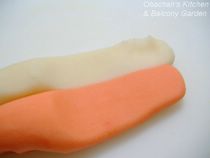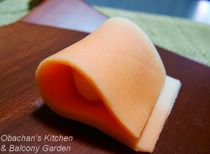練り切り Nerikiri (What should I name this? Any idea?) Now I’m very proud of the progress I made. This was the nerikiri I made in autumn 2005. Just like a kid’s work with playdough, isn’t it? Now look at the top photo, my best work this time. What do you say? A teenager’s work with playdough, maybe? ;P I tried making a color gradation with white and orange dough, and I think I did a good job for the first try.  Nerikiri is basically sweetened white bean paste, but often yam or gyuhi is added to make it smooth and flexible. Last year I tried adding steamed yam, so this time I tried adding gyuhi. Gyuhi is made by mixing mochiko (rice flour), water and sugar over a low heat. The trick I used this time was adding a little egg white when mixing rice flour and water. I read somewhere that egg white is often used to make wagashi whiter, and somehow I thought it would be better to mix it with gyuhi than with the bean paste, though I can’t really tell you why. Anyway, it seems to have worked. Nerikiri is basically sweetened white bean paste, but often yam or gyuhi is added to make it smooth and flexible. Last year I tried adding steamed yam, so this time I tried adding gyuhi. Gyuhi is made by mixing mochiko (rice flour), water and sugar over a low heat. The trick I used this time was adding a little egg white when mixing rice flour and water. I read somewhere that egg white is often used to make wagashi whiter, and somehow I thought it would be better to mix it with gyuhi than with the bean paste, though I can’t really tell you why. Anyway, it seems to have worked. The technique of making a color gradation is called “bokashi.” You combine two pieces of dough in different colors and roll them out together. Then you fold it and roll it out again, as described in this site. (Scroll down to find the bokashi part). Notice that the borderline between the two colors in the upper half is not brought exactly onto that in the lower half. This slip is what that makes the color gradation. The technique of making a color gradation is called “bokashi.” You combine two pieces of dough in different colors and roll them out together. Then you fold it and roll it out again, as described in this site. (Scroll down to find the bokashi part). Notice that the borderline between the two colors in the upper half is not brought exactly onto that in the lower half. This slip is what that makes the color gradation.It was so much fun playing with the color, and the texture of this gyuhi-mixed one was 100 times better than what I made last year. Honestly. With nice, hot green tea, this nerikiri made a perfect dessert to conclude my kaiseki project in autumn 2006.   ---- So this was obachan’s crazy kaiseki weekend in November 2006. Hope you enjoyed it as much as I did ;) Oh, if you don't mind, can you tell me which dish you liked the best and why? Categories: Japanese |
Wednesday, November 22, 2006
菓子 Kashi (Dessert)
Posted by
obachan
at
11/22/2006 10:02:00 AM
![]()
Labels: Home-made wagashi
Subscribe to:
Post Comments (Atom)


















18 comments:
Goodness! You were able to do all that from watching the chefs at your kaiseki restaurant? I don't think you give yourself enough credit. These dishes are beautiful.
For my favorite dish, I can't decide between the Walnut Tofu and the Saikyo Yaki. Saikyo Yaki is one of my favorite Japanese dishes, but the Walnut Tofu looks so mysterious and tempting. It's a very tough decision.
- Chubbypanda
Oh my gosh, Obachan! It ALL looks so beautiful and delicious! Choosing one as best is impossible! The sunomono and agemono are beautiful and I love both. I'm especially liking your gingko sweet potato! And even though I just ate dinner, my mouth is watering looking at the pictures of your yakimono. Great job on everything!
Wow! That's amazing! You are amazing!!
Everything looks so good! I have to say that I find the dessert most tempting -- I think it's the colour gradation that really makes it stand out, for me.
wowee, obachan, it's hard to choose just one! the walnut tofu looks delicate and peaceful, but may ichoose the steamed fish with turnip because it's now dinner time? haha! i second everyone on the kashi dessert. it looks like an image from children's fairy tale.
...a standing ovation for you obachan! don't forget art isn't just for the elites. it's what's in your will, heart and soul (LOL just some cheese for your non-kaiseki dishes:P)
Holy crap Obachan!! This is amazing. I am awestruck. Speechless. I can only dream of being able to create such a menu!
My favorite is the whole Autumn plate. It sums up what I think of kaiseki - seasonal ingredients with a direct association to the natural surroundings.
I have the wheels turning in my head about how to create something like this!
Wow! I love your dessert and the walnut tofu. I've heard of sesame tofu, but not walnut, something new!
chubbypanda
No, no, not just from watching the chefs. I already knew how to make some of the dishes, and for the new challenges, I consulted things like Mr. Murata’s book and Japanese recipe websites.
So happy to find another saikyo-yaki fan, because that’s my favorite, too. Hope you have a chance to try walnut tofu someday. It’s really worth trying.
amanda
Thanks for mentioning the agemono, because it took me a while to come up with that presentation in the photo. Taste-wise, the saikyo-yaki was the best of all this time.
anonymous commenter
Thank you! :D
ghanima
Oh, I’m glad that you liked the dessert. I was so happy with that color gradation, too.
edmame
The steamed fish with turnip tasted so good. I wasn’t totally happy with the way it was presented, but I loved the taste. Especially, it was good to have a warm, comforting steamed dish in the kaiseki course this time in place of the clear soup or simmered dish that I omitted.
Thank you so much for your standing ovation. “Art isn’t just for the elites.” I love this. You gave me courage to go for more reckless challenges in the future. ;)
lucas
Oh, thank you so much for mentioning the autumn plate. I was hoping that someone would appreciate that dish like the way you did. You read my mind!
Let the wheels turning and pretty soon you’ll be making your own creative Japanese meals, I think. :)
k & s
Hope you have a chance to try walnut tofu. It’s really worth trying. Personally I like it better than sesame tofu.
To me, sesame tofu was a hit-or-miss… sometimes it had overwhelming amount of ground sesame seeds which made the flavor and the texture just “too much” for me. The best one I had was the one they served at a small temple in Nara (IIRC).
oh god.how amazing are you! if i could make one of those dishes how happy i would be.....very inspiring and mouth watering!
Thank you. I bet you make lots of mouthwatering dishes, too. :)
Obachan I wrote you 2 long messages and when I sent them they dissapeared, so now I just say congratulations
AHHHHHHHHHHH! So sorry, Mr. Food. I, too, had the same problem a couple of times before so I know how you felt. I don't know how to improve it... I wonder if it's the problem of blogger's comment system itself or the problem of this particular template...
Anyway, thank you for writing me long messages though I missed them. Hope they were not complaints about me disgracing Mr. Murata's walnut tofu recipe. ;)
i think i liked the walnut tofu the best, because it's something really different!
but the dishes that are in close second place are the broiled sea bream and the tempura.
i'd be really interested in trying out the mushimono though....and the rice looks lovely...true comfort food~~
Hi evangeline,
Oh I really wish you have a chance to taste good, authentic walnut tofu someday. It is REALLY good. The mushimono is also a good winter food. :)
Dear Obachan, thank you for posting such a delightful blog. Your modesty is almost unbearable in that the work of yours you show is of very high quality, especially for a self-proclaimed amateur. The link you provided for the two-tone “bokashi” was simply astounding. I must now try and find some of the carved wooden molds they showed to include in my culinary equipment collection. If you have any information about them, please feel free to post it.
Thank you so very much for providing a first-hand account of working in the kaiseki environment. It has obviously rubbed off upon you to an admirable extent. If you were here in California, I would physically drag you over to the culinary institute where I occasionally help teach so you could give a lecture. My last two years were spent managing catering operations and your accounts are simply wonderful to read about. Be certain that I will be looking for Murata’s book on kaiseki. Fortunately, there is a Kikokuniya bookstore only a few miles from my house. With much respect and admiration,
Zenster
Hi Zenster,
Well, your generous compliments are almost making me blush now. :D
About the wooden molds… I googled with “kashigata” and found some on eBay, but most of theirs seem to be the shallow type used for making rakugan (wagashi made by molding moistened sugar), not nerikiri. And many of them are expensive antiques. Sorry I couldn’t be of much help.
Maybe, as a dishwasher, I could give the students some tips on washing and drying some Japanese eating utensils, but not on cooking. ;)
Dear obachan,
Your blog is one of my favourites! I am a Japanese Canadian woman living here in Vancouver, BC. Canada. I was just searching on "nerikiri" desserts when I ran into your blog. Just beautiful! Please keep up with the good work. My mother brings home some nerikiri desserts every 2nd week of the month where she has her Japanese Women's Seminar. I was just facinated by these desserts! it's really too beautiful to eat them. I'll keep checking back on you often!
cocogirl
Hi cocogirl,
Thanks for your comment and sorry that I didn't respond earlier. It's nice to hear that nerikiri is available over there in BC, Canada.
Hope you keep coming back to this blog and enjoy the photos of Japanese sweets!
Post a Comment